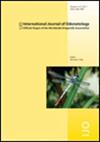Ecology of Mesamphiagrion laterale (Odonata: Coenagrionidae): abundance, reproduction and interactions with co-occurring species
IF 1
4区 农林科学
Q3 ENTOMOLOGY
引用次数: 6
Abstract
The behavior of Mesamphiagrion laterale (Selys, 1876) is described based upon 2430 hours of observation. A total of 2820 individuals were observed for 270 days from 2014 to 2015 using mark-recapture. Probabilities of resight, highest reproductive activity, time-perch and time of perch-temperature were statistically analyzed. Mesamphiagrion laterale is not a territorial species, the individuals perch on grass, trees, garbage, ground, and rocks, they feed on hemipterans, mosquitoes, spiders and other damselflies, and are prey to spiders and birds. Conspecific siege and interspecific interactions by perch were observed. No courtship was observed. During tandem, which lasted for 3–90 min, the ventral side of the male’s abdominal segment 2 was in contact with the female’s abdominal segments 8–10 until a wheel was formed. We observed three tandem pair combinations: sexually mature males and females, immature males with mature females, and immature males and females. While copulation lasted from 7 to 20 min, oviposition lasted from 12 to 15 min. Irrespective of male presence, oviposition occurred in submerged or emerged areas of Eichornia crassipes. We recorded the highest reproductive activity between 12:00 and 12:35 (Colombia Time-COT, UTC-5). Above 20°C, a larger perching area close to the water allows more reproductive events. However, a more extensive canopy cover impedes achieving optimal reproductive temperatures. Species interactions within this community may be explained by temporal and spatial niche partitioning.侧边密角蝽的生态学:丰度、繁殖及其与共生物种的相互作用
根据2430小时的观测,描述了Mesamphiagrion laterale (Selys, 1876)的行为。2014 - 2015年,采用捕鼠法对2820只个体进行了270天的观察。统计分析复明概率、最高繁殖活动概率、栖息时间概率和栖息温度概率。Mesamphiagrion laterale不是一个领地性物种,个体栖息在草地、树木、垃圾、地面和岩石上,以半翼虫、蚊子、蜘蛛和其他豆豆蝇为食,是蜘蛛和鸟类的猎物。观察了鲈鱼的同种围捕和种间相互作用。没有观察到求偶现象。在3 ~ 90min的串联过程中,雄虫腹部2段腹侧与雌虫腹部8 ~ 10段接触,直至形成轮体。我们观察到三种串联配对组合:性成熟雄性和雌性、未成熟雄性和成熟雌性、未成熟雄性和雌性。交配时间为7 ~ 20 min,产卵时间为12 ~ 15 min。不论雄虫是否存在,均可在水淹区或露出区产卵。我们记录了12点至12点35分(哥伦比亚时间- cot, UTC-5)的最高繁殖活动。在20°C以上,靠近水的更大的栖息区域允许更多的繁殖活动。然而,更广泛的树冠覆盖阻碍了获得最佳繁殖温度。群落内物种间的相互作用可以用时空生态位划分来解释。
本文章由计算机程序翻译,如有差异,请以英文原文为准。
求助全文
约1分钟内获得全文
求助全文
来源期刊

International Journal of Odonatology
ENTOMOLOGY-
CiteScore
2.30
自引率
0.00%
发文量
15
审稿时长
>12 weeks
期刊介绍:
International Journal of Odonatology (IJO) is aimed at providing a publication outlet for the growing number of students of Odonata. It will address subjects such as the ecology, ethology, physiology, genetics, taxonomy, phylogeny and geographic distribution of species. Reviews will be by invitation, but authors who plan to write a review on a subject of interest to the journal are encouraged to contact the editor.
 求助内容:
求助内容: 应助结果提醒方式:
应助结果提醒方式:


